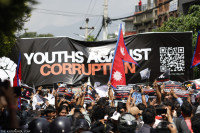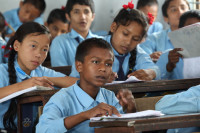Opinion
Pleasant surprise
The chance trilateral meeting on the sidelines of the Brics Summit was very fruitful
Rishi Raj Adhikari
A Brics-Bimstec Outreach Summit was held in Goa, India from October 15-17. It was the eighth Brics summit held under the chairmanship of India, and its theme was Building Responsive, Inclusive and Collective Solutions. Brics, an association of five major emerging economies of Brazil, Russia, India, China and South Africa, accounts for 42 percent of the world population, 30 percent of the world GDP and 17 percent of global trade. Likewise, Bimstec (Bay of Bengal Initiative for Multi-Sectoral Technical and Economic Cooperation) is an international grouping comprising Bangladesh, India, Myanmar, Sri Lanka, Thailand, Bhutan and Nepal. Brics and Bimstec together account for 53 percent of the world population.
Indian Foreign Minister Sushma Swaraj thought the summit would focus on institution building, implementation of commitments carried over from past summits and exploring synergies among the existing mechanisms. Enhancing greater people-to-people participation during Brics events would also be another priority. The acronym Bric was first used in 2001 by Goldman Sachs in their Global Economics Paper entitled The World Needs Better Economic BRICs, which was based on econometric analyses projecting that the economies of Brazil, Russia, India and China would occupy far greater economic space and be among the world’s largest economies in the next 50 years or so.
Positive response
Bric was launched following a meeting between the leaders of Russia, India and China in St Petersburg on the margins of the G8 Outreach Summit in 2006. The grouping was formalised during the first meeting of Bric foreign ministers on the sidelines of UNGA in New York in 2006, and the first summit was held in Yekaterinburg, Russia in June 2009. Bric expanded into Brics with the inclusion of South Africa in September 2010.
Seven Brics Summits have taken place so far. The eighth Brics Summit was hosted by India during its chairmanship in 2016. Starting essentially with economic issues of mutual interest, the agenda of Brics meetings has considerably widened over the years to encompass topical global issues. Brics cooperation has two pillars—consultation on issues of mutual interest through meetings of leaders and ministers of finance, trade, health, science and technology, education, agriculture, communication and labour, among others, and practical cooperation through meetings of working groups and senior officials and annual summits.
As the chair of the Eighth Brics Summit, Indian Prime Minister Narendra Modi invited Bimstec members and also Saarc members Maldives and Afghanistan who are not part of Bimstec. Pakistan was not invited, and it was intriguing to witness its glaring absence at the summit. Many foreign relations experts see it as part of an attempt by India to isolate Pakistan from the regional scene.
Prime Minister Pushpa Kamal Dahal ‘Prachanda’ had an unplanned trilateral meeting with Chinese President Xi Jinping and Indian Prime Minister Modi on the sidelines of the Brics-Bimstec Outreach Summit. He expressed Nepal’s desire to act as a ‘dynamic bridge’ between the two Asian giants and reap the benefits of such a role during the chance gathering on October 15. He also raised issues of trilateral cooperation on the socio-economic front, to which both the Chinese and Indian leaders responded ‘positively’. “Nepal can benefit greatly from the economic progress of China and India if there is trilateral cooperation,” Prachanda told reporters at the Tribhuvan International Airport upon his return from the summit.
Nepal’s interest
The trilateral meeting was a pleasant surprise for Prime Minister Dahal. He was waiting in the Leader’s Lounge to return to his hotel when President Xi entered the room. They discussed various bilateral issues and full implementation of the deals that Nepal and China had sealed in the past. President Xi’s prospective Nepal visit, implementation of the constitution and conclusion of the peace process were also discussed during this meeting. It was a one-on-one meeting, which lasted about 20 minutes. Later, Indian Prime Minister Modi also dropped in. Prachanda had wanted to hold such a meeting among the three leaders; and when it happened by chance, it was a ‘rare and pleasant surprise’ for him. The circumstance of this ‘chance trilateral’ meeting was also echoed by Indian and Chinese foreign ministry officials. The meeting has opened a platform for more formal and systematic meetings in the future. It leaves no room for any controversy here in Nepal and elsewhere as all three parties have described it as being positive.
The Outreach Summit was preceded by a Retreat Meeting including the leaders of Bimstec. This summit has provided an important occasion to explore areas of strategic partnership between the two dynamic groups of countries. During the Outreach Summit and Retreat Meeting, Prime Minister Dahal spoke on countering terrorism; addressing environment and climate change and disaster management; enhancing connectivity and promoting cooperation in agriculture, energy, trade, technology, tourism, poverty alleviation and people-to-people contact. The summit has adopted a 109-point outcome document for promoting regional cooperation. Prime Minister Dahal also had bilateral meetings with leaders of Brics and Bimstec countries such as India, China, South Africa, Sri Lanka and Bhutan.
Addressing Parliament after returning from the summit, the prime minister said that he had raised the issue of regional connectivity, regional contact network, energy development and expansion of people-to-people contacts. He also talked about his meetings with different heads of state and government. Prime Minister Dahal emphasised that efforts had been made to strengthen bilateral relations with India and China while maintaining high-level diplomatic norms, and that these relations would be strengthened by keeping the welfare of Nepal and Nepalis uppermost in mind.
Adhikari is foreign affairs advisor to the prime minister




 16.12°C Kathmandu
16.12°C Kathmandu










